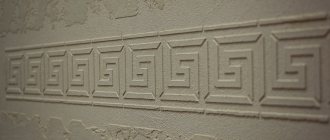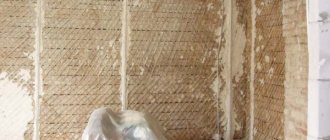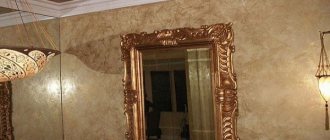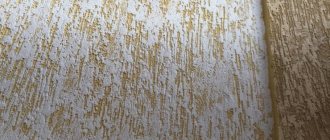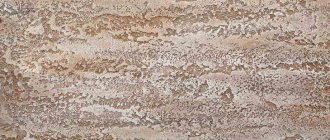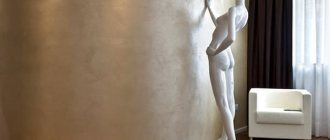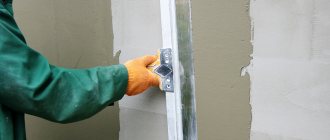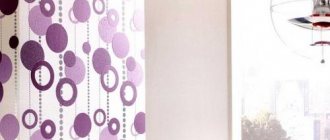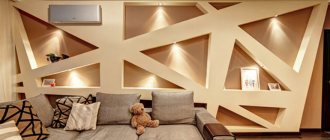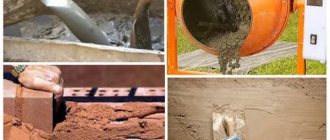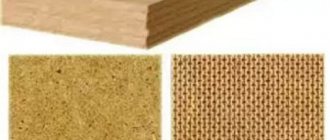Stencils for decorative plaster help you create three-dimensional patterns on the wall without much difficulty. Their use is simple, so you can carry out original surface design yourself without spending money on the services of professionals. The features of using stencils for plaster and their selection will be discussed in detail below.
Stencil painting - what is it?
Stencil painting involves obtaining a three-dimensional pattern on a plaster layer, which is applied using special templates. These stencils help you apply any even complex pattern without much effort.
They are a material in which the desired images are cut out, and an additional layer of plaster is applied through them so that the result stands out from the main surface. This way you can get a bas-relief on the ceiling and walls.
Stencil painting involves obtaining a three-dimensional pattern on a plaster layer, which is applied using special templates.
How to use a stencil for bas-relief
If this is your first time holding in your hands a template for creating three-dimensional patterns with decorative plaster, do not rush to immediately start changing the decoration of the walls. First, carefully study the technological process of using the stencil, or even then try it on a piece of drywall or where a bad experience will not be noticeable. To work, in addition to the template film, you will need masking tape or aerosol glue, or better yet, both. You will also need a container for the plaster mixture, a spatula and, possibly, a paint roller.
The advantages of this type of wall decoration
Stencils for three-dimensional plaster will give you the opportunity to create an unusual room design with your own hands. This effect has the following advantages:
- You can buy ready-made stencil designs or make them yourself;
- You can show your creativity by making the interior unique;
- It’s easy to apply even a complex design without any artistic skills;
- Get more unique designs than those presented on special textured rollers;
- The decor can be obtained on any type of plaster layer;
- Helps cover minor imperfections in the base.
Stencil plaster looks beautiful, even if the color is made the same as the rest of the part. You can separately highlight three-dimensional patterns, then the space will visually increase.
Stencils for three-dimensional plaster will give you the opportunity to create an unusual room design with your own hands.
Materials for making templates
Paper is most often used to create templates. This material is accessible and easily attached to any surface. You can cut out any elements from it without much difficulty; all you need to do is have scissors on hand.
For more accurate application of thin lines of the image, it is better to use self-adhesive film
Cardboard is a more reliable material for a template, but it is difficult to cut curves out of it. The advantage is that stencils made from it can be used several times.
Self-adhesive film is great for making a template. It is easily attached to the wall and can be removed after applying the design. It can be washed and used again.
Long-lasting stencils can be made from plastic, but cutting out designs in this material requires special tools and considerable effort.
How to choose the right pattern for a room
Stencils for walls for decorative plaster must be selected correctly so that they look consistent with the interior and perform a complementary function. You can recreate elements that are on furniture pieces and other decor in the room. They are often used in children's rooms to create colorful images of cartoon characters and more.
In other rooms you can use the patterns described below:
- It imitates stone or brick and is used for the kitchen, hallway, and living room. Rolled templates are sold that can be conveniently stretched over the surface;
- Natural motifs are applicable to any room. Well suited for the bedroom, if a large pattern is chosen, then the room should be large;
- Animals and birds can be depicted large, but they are not suitable for many styles;
- Reptile skin or animal skins can cover the entire area, or only certain areas.
Stencils for walls for decorative plaster must be selected correctly so that they look consistent with the interior and perform a complementary function.
Recommendations and common mistakes
When decorating a room, it is important to avoid mistakes, so you need to familiarize yourself with some tips. Recommendations for using stencils for decorative plaster:
- The working tool must be held perpendicular to the wall.
- To prevent lint from getting into the picture, apply the plaster in a circular motion.
- For volumetric drawings, take a sufficient amount of plaster. It is recommended to remove its remains immediately.
- Immediately after completing decorative work, reusable templates are washed well with warm water.
- To protect the ornament from the influence of external factors, after drying it is coated with varnish.
The layout is usually a printed picture, which is transferred to the material for making stencils
In order for the image on the wall to be of high quality, it is important to observe the following points:
- The surface must be clean and free of grease.
- Using a building level and a pencil, it is important to mark the location of the image on the wall.
- In order not to spoil the wall with an incorrectly applied mixture, it is recommended to first display the drawings according to the template on ordinary Whatman paper.
- To ensure good bonding of the stencil to the wall, you need to use a special stencil adhesive.
- It is better to apply drawings on walls using acrylic paints; plaster is used to display three-dimensional patterns.
If you follow the tips listed above, you will be able to avoid mistakes when decorating walls.
Photos of stencils for decorative plaster will help with choosing a design:
- Simple curls will decorate a living room or bedroom.
- A geometric pattern will allow you to separate part of the wall.
- The honeycomb pattern is suitable for the kitchen, living room.
- An ornate ornament will make the room worthy of admiration.
- Using a stone stencil you can successfully transform your kitchen space.
How to make it yourself
If you don’t want to look for a suitable pattern on sale and spend additional money on them, then you can make the template yourself. Then you can get any image you like. Materials you can choose from are plastic, paper and silicone.
If you don’t want to look for a suitable pattern on sale and spend additional money on them, then you can make the template yourself.
Made from silicone
Silicone material can be used to cut out the desired image on the sheet. You can also apply a pattern using silicone-based glue.
For the latter option, it is convenient to use a special glue gun. They work on a flat surface, lay down paper with a pattern, lubricated with oil. Once drying is complete, it will be easy to remove the silicone.
Silicone material can be used to cut out the desired image on the sheet.
Plastic
Use a thin type of plastic 0.2 mm. For example, you can apply folder covers that are sold for files. They come in different sizes. You can redraw the pattern with a regular marker.
When cutting an image, try to avoid jagged edges.
Use a thin type of plastic 0.2 mm.
Papers
The paper stencil will be disposable; it is better to choose a dense type. So that he can withstand the solution. You can transfer the image tightly by pressing the stencil paper against the template, drawing an outline with a marker.
The paper stencil will be disposable; it is better to choose a dense type.
Types of stencils
As a rule, stencils sold in construction or design stores are made of PVC. However, in addition to them, there are templates made from other materials.
- Plastic. Such templates will last longer than others, and depending on the thickness, they will allow you to make a pattern that protrudes above the plane to varying degrees.
- Rubber or silicone. They are also quite durable, but unlike plastic analogues, they are easier to remove from the surface.
- Paper. The cheapest and most short-lived (disposable) stencils. It makes sense to use it if you do not plan to make many repeating parts.
Stages of painting work
To get a high-quality result with your own hands, you need to carry out the process in compliance with technology. The base must be cleaned and all unnecessary parts must be removed. A location for the pattern is selected and markings are made to place the pattern in the desired location.
It is important to fix the stencil well; for this purpose, special glue is used, which will not be visible on the surface. But it’s easier to use double-sided masking tape.
If the drawing is large, then the parts must be securely connected together, so that there is no movement in the image. The plaster mixture or paint is being prepared. For details of the process, see the manufacturer's instructions.
The base must be cleaned and all unnecessary parts must be removed.
Making a stencil
The stencil must be carefully transferred to the selected material. You need to cut out the pattern with sharp tools so that the edges are even. You can strengthen the paper base by taping it with tape. You can draw a picture, or use a printout of the finished version.
You can draw a picture, or use a printout of the finished version.
Drawing with paint
To obtain a clear image, you must adhere to the work rules. Experts highlight the following principles:
- Provide reliable fixation of the template to the surface;
- The tool is used to select printed options for applying the composition;
- You can only use a clean and dry stencil for painting;
- The template is removed immediately after coating with paint; you should not wait for it to dry, then removal will occur with partial removal of the layer.
The tools you can choose from are:
- Special brush for stencils. It is round and the bristles lie flat. You don’t need to add too much paint so that it doesn’t run down the stencil onto the wall;
- Foam sponge;
- The roller is made of foam rubber, it is suitable for large areas, so that the image is bright in all areas, you need to roll the paint with a roller several times.
The template is removed immediately after coating with paint; you should not wait for it to dry, then removal will occur with partial removal of the layer.
Creating a relief image
The material should be applied in stages to make the pattern voluminous. First, the image is fixed to the surface. Then perform the following steps:
- Using a narrow spatula, the plaster is applied, and with a narrow spatula it is already distributed according to the template; it is important to completely cover the cut out parts. They work with effort;
- When the pattern is transferred, the stencil is removed;
- You can make adjustments with a small tool before the layer dries;
- If you have applied extra strokes, they can be cleaned after drying with sandpaper;
- The surface can be painted with acrylic or latex based paints. Options in spray cans are convenient, but it is better to paint the bas-relief pattern with a foam roller.
You can make adjustments with a small tool before the layer dries.
What to make a stencil for plaster from
Impressions on slightly dried plaster can be made using a special shaped roller. Thanks to the templates, three-dimensional pictures, protruding patterns, and unique layers are drawn on the walls.
A stencil for plaster can be made from paper, plastic or silicone.
The paper version is printed on a printer or drawn by hand, cut out according to ready-made patterns. Such templates are attached to the walls with tape and plaster is applied. They have a minimal cost, but are disposable.
Plastic stencils can be cut from bottles or other packaging. The selected picture is transferred to plastic and cut out with a stationery knife. Such templates are attached to the walls with special glue.
The simplest and most reliable stencil is the silicone version. The picture is poured onto a sheet of paper with silicone glue. After complete drying, the paper is removed, and the resulting reusable product is used to decorate the walls.
A mold for gypsum plaster will allow you to decorate in a short time
Tools that will come in handy at work
Work can be carried out without interruptions if you prepare all the necessary tools in advance. The list includes the following tools:
- Spatulas;
- Roller;
- Palette knife, for correcting defects;
- Stationery scalpel;
- Tassels;
- Sandpaper;
- Markers;
- Templates;
- Containers for solutions.
Work can be carried out without interruptions if you prepare all the necessary tools in advance.
Methods of applying paints
Paint can be applied in several ways:
- using a brush;
- sponge;
- from a cylinder;
- roller;
- using a sprayer.
When working with a can or sprayer, it is recommended to try how the paint is sprayed at different distances, and then use the appropriate option. This method is suitable for using external stencils.
Options for beautiful designs
Any patterns can be chosen at the discretion of the owner. You can look for inspiration on the Internet, or come up with a picture yourself and draw it if you have artistic abilities.
For living rooms, you can choose large designs if there is a large empty area. Narrow patterns around doors and windows look beautiful; switches and sockets are decorated with patterns. Natural patterns are appropriate in any interior.
For living rooms, you can choose large designs if there is a large empty area.
Stencils for the plaster layer allow you to quickly update your interior without spending a lot of money. It is important to choose a pattern, taking into account the design features, in order to get a compatible addition. If I follow the working technology, it will not be difficult to create a three-dimensional bas-relief.
Features of working with large stencils
In this case, the template is divided into several parts, so it will be more convenient to mount it on the wall. If you need to create a whole pattern without a seam, you should use a joint or glue two templates, one next to the other. Help from a second person will make the task easier.
The material for the sketch is selected more durable. As a rule, manufacturers choose reusable hard plastic.
If it is not possible to cut the layout into pieces, it is better to secure it with tape in several places. Matte masking tape is the best solution. Fastening is carried out not only on four sides (top and bottom corners), but also in the middle of the stencil.
Useful tips
If you can’t or don’t know how to make stencil templates for decoration, then entrust this task to someone who can do it for sure.
As for the whole process, experts recommend paying attention to some nuances:
- When painting, you don't need to put a lot of paint on the brush. It can flow down and get under the stencil.
- When working with a brush, do not rush and make only smooth strokes so that the paint has time to settle evenly on the surface.
- After dismantling, the template must be carefully processed without leaving paint.
When using a roller, it is better to go over the wall one more time, slightly wet it and wring out the tool, rather than try to remove excess paint later, thereby ruining the appearance.
Work technique
To apply the stencil, you will need to have the template itself, sandpaper, spatulas of different sizes, sandpaper, decorative color coating and spray glue. Technique:
- Aerosol glue is applied to the layer of decorative plaster. The composition is coated in the part where the stencil will be glued (i.e., the part facing the wall). After such application, no traces remain either on the form or on the wall. Wait for the glue to set well.
- After the stencil is finally secured with a spatula, a layer of decorative plaster is laid. Using the tool, a small amount of solution is scooped up and carefully applied to the template. The strokes are made strong so that the adhesion of the material is as strong as possible.
- You need to apply such an amount of plaster that will allow the stencil to completely disappear.
- When the solution has completely dried, carefully remove the stencil from the surface. It is important not to disturb the formed pattern and not damage any element.
- A more voluminous effect can be achieved by covering several layers of the mixture.
- To correct shifted elements or cracked parts, you need to go over the drawing with sandpaper to correct any errors in the work.
- The volumetric element can additionally be coated with a decorative color coating. This must be done when you want to get an additional shade or give the picture an unusual shine.
Advice
Even a beginner can independently apply the finish using a template to the wall. If you want to create a three-dimensional drawing on the ceiling, then you need to apply some skills and abilities. It is best to entrust work with vertical surfaces to a specialist.
Where can I buy a stencil image for bricks and other things?
Attention
You can order templates from online stores, of which there are many online. By entering your city of residence, you can determine the supplier and indicate the production time of the required model.
You can also purchase such forms at the nearest store in the city. Although it is not always possible to select a stencil image right away. Then you should place an order, fill out an application on the website or voice it to the operator by phone. The design of the future layout can be made right before your eyes . You can make adjustments during this process.
A stencil for decorative plaster is often used when decorating living rooms. But the decor in non-residential areas also turns out beautiful. A special atmosphere is created there, which predisposes to relaxation, work or active activities.
Most popular patterns
Among the variety of designs, ornaments and patterns, there are a number of decorations that have won the greatest recognition. They successfully complement and emphasize the design and style of the interior.
Most popular images:
- trees, shrubs, plants and flowers - they are performed in full form or partially (individual branches and petals, buds and inflorescences, combined compositions);
- all representatives of the animal world and birds - from large silhouettes of wild animals to miniature images of pets;
- various landscapes in a variety of options - rocky mountains, lush green plains, seas and small streams, sandy shores and other picturesque views;
- ornaments of all world cultures - with Oriental, Asian and European motifs;
- hieroglyphs and elements of various symbols;
- imitation brick, savage, marble or artificial stone;
- geometric figures.
When choosing a theme, it is important to take into account the size of the room, its purpose and the style of the interior. Relief plaster acts as a bright accent, so the decor should fit harmoniously into the overall style of the space.
